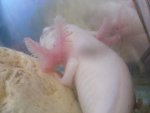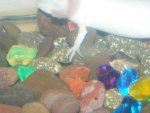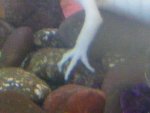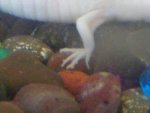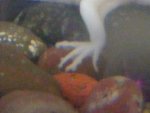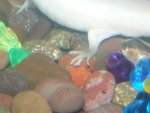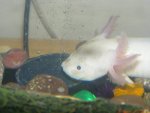Hi Jodie and kerry,
The lesions on the feet are likely to be (80-90% chance) mycobacterial abscesses. This type of bacterial abscess is different to usual types of bacterial infection. Once an axie gets this, it is almost impossible to completely eradicate it from their system. The infection is carried systemically throughout their body in deeper tissue layers, internal organs, blood and lymph.
The axie is a permanent carrier and will continually flare up, recrudesce and shed infectious particles. This bacteria can also transiently affect other species and humans. Hence you would have to permanently isolate this axie from any other axies. Feeder fish cannot be 'shared'. You would also have to avoid touching the axie with your bare hands.
The infection is quite covert and insidious in that many axies that are carriers can look outwardly quite fine, but in times of stress, concurrent illness, malnutrition etc., it quickly takes over and start forming these multiple nodular abscesses throughout the body. The most likely regions for these to first form are in the feet due to the fine blood vessel network that 'traps' microscopic clusters of bacteria (septic emboli).
Carriers normally leave some tell tale signs. They are runty, susceptible to illnesses, poor conformation or might start out having small red patches on the body. When the disease takes hold, microabscesses will form not only on the skin but internal organs. Kidneys and liver may be affected, the rudimentary lungs and gills may be affected, even the brain. The clinical signs will vary in severity depending on the organs involved. Many axies with severe stage of this infection will succumb to respiratory distress, osmo-regulatory imbalances, anaemia and other general illness signs.
You would have to fridge the axie and make a vet appointment. It will be highly recommended you get the vet to perform a culture and acid-fast stain on samples collected. I also highly recommend getting an antibiotic sensitivity test done. This bacteria is very resistant to many antibiotics and many more effective drugs used in other species cannot be used on axies. The selection of drugs to use is very limited. Amikacin and Enrofloxacin can help in some cases, but in my experience even a lot of them don't respond to these two antibiotics. A note not to perform any salt or tea baths. These baths will force the bacteria deeper into tissue layers and get even more difficult to treat.
I hope it goes well for you. My golden albino (apollo) died yesterday from battling this condition for 3 years. It just deteriorated to the point the quality of life is so affected that i just euthanased it. I hope you get the axie to the vet in time to prevent it from getting worse.
Cheers.

